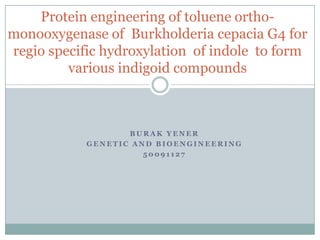
Protein engineering of toluene ortho-monooxygenase of Burkholderia cepacia G4 for regio specific hydroxylation of indole to form various indigoid compounds
- 1. Protein engineering of toluene ortho- monooxygenase of Burkholderia cepacia G4 for regio specific hydroxylation of indole to form various indigoid compounds BURAK YENER GENETIC AND BIOENGINEERING 50091127
- 2. What is Indigo? Indigo dye is an organic compound with a distinctive blue. Historically, indigo was a natural dye extracted from plants, and this process was important economically because blue dyes were once rare. Nearly all indigo dye produced today — several thousand tons each year — is synthetic. It is the blue of blue jeans. http://en.wikipedia.org/wiki/Indigo_dye
- 3. Indigo Nature indigo plant extract sample The production of indigo is primarily by chemical syntheses, such as the Adolf von Baeyer chemical synthesis of 1890 (Gillam et al. 2000) which resulted in the fifth Noble prize in chemistry. http://upload.wikimedia.org/wikipedia/commons/1/18/Indigo_plant_ extract_sample.jpg
- 4. Chemical Structure of Indigo http://upload.wikimedia.org/wikipedia/co mmons/c/c7/Indigo.svg
- 6. C-3 oxidation and forming indigo
- 7. C-2 oxidation and forming isoindigo
- 8. Aims Of This Study The aims of this study were to create different color producing TOM variants via DNA shuffling, to discern the important residues that cause the formation of these various colored products. Explore the altered patterns of indole hydroxylation by E. coli TG1 expressing TOM with amino acid variations at positions V106 and A113 of the hydrolase α-subunit (TomA3) Explanation at the molecular level for why indole was oxidized in three possible ways (hydroxylation of indole at C-3, C-2, and at both C-2 and C-3 )
- 9. Methods E. Coli TG1 strain and pBS(kan)TOM plasmid used. DNA shuffling of TOM Saturation mutagenesis and DNA sequencing Thin-layer chromatography (TLC) High performance liquid chromatography (HPLC) Liquid Chromatography - Mass Spectroscopy ( LC- MS)
- 11. Saturation mutagenesis is a form of site-directed mutagenesis, in which one tries to generate all possible (or as close to as possible) mutations at a specific site, or narrow region of a gene. Thin layer chromatography (TLC) is a chromatography technique used to separate mixtures. Thin layer chromatography can be used to monitor the progress of a reaction, identify compounds present in a given mixture, and determine the purity of a substance. HPLC, is a chromatographic technique used to separate a mixture of compounds in analytical chemistry and biochemistry with the purpose of identifying, quantifying and purifying the individual components of the mixture. Liquid chromatography–mass spectrometry Generally its application is oriented towards the general detection and potential identification of chemicals in the presence of other chemicals (in a complex mixture)
- 12. Results
- 13. Results Fig. 2 a,b Colored compoundsproduced by TOM variants. a) Colored chloroform culture extracts of TOM variants with mutations at position TomA3 A113, along with standards (indigo, indirubin, isatin, isoindigo). b) Cell color extracts of TomA3 A113G mutants
- 14. Discussion Results showed that random mutagenesis of TOM led to the identification of the key sites V106 and A113 that are responsible for the different indole hydroxylation patterns. Saturation mutagenesis at these key sites resulted in the discovery of more diversified indole hydroxylation which allows a single enzyme for the first time to make a diverse range of indigoid compounds.
- 15. Discussion Single or double amino acid change can create catalytically distinct enzyme variants that hydroxylate indole in different regiospecific positions on the pyrrole and benzene rings. TOM may partly, if not completely, control the oxidative coupling of indole derivatives to form dimeric conjugates, although indoxyl is normally believed to form indigo by non- enzymatic condensation and oxidation. These dramatic effects on indole hydroxylation are caused by A113 and/or V106 substitution. Although there is no direct evidence, it seems that the identity of residues V106 and A113 not only determines the binding orientation of the substrate and its regiospecific hydroxylation but also influences the subsequent dimerization.
- 16. Discussion Along with the diversified products distributions in Table 1 that are not easily explained by different hydroxyindole formation rates, it appears the enzyme may be controlling both dimerization and the position of hydroxylation of the benzene or pyrrole ring.
- 17. Thank You